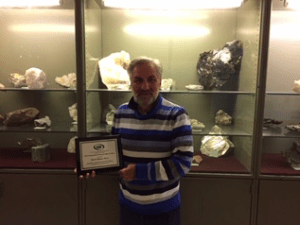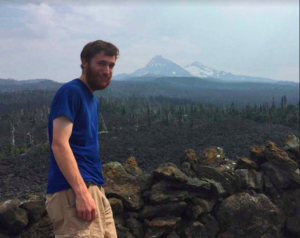
Oct 24, 2019 | News |
Chris Canavan Contributing Writer
Dr. David Gibson, a UMF professor since 1996, has been awarded the 2019 Undergraduate Research Mentor Award by the Geosciences Division of the Council on Undergraduate Research (CUR).
This national award “recognizes the critical work of a geoscience faculty member who serves as a role model for productive and transformative student-faculty mentoring relationships,” according to a UMF press release regarding the accomplishment. Gibson received his award at the National Geological Society of America Conference held in Phoenix, Arizona.
Gibson says that he had been interested in providing students with opportunities to conduct field research since he first started at UMF. In fact, he was specifically asked by students at his job interview if he would take them out to conduct field research. “Someone can look at pretty textbooks all day long [but] on- the-ground observation is really key,” says Gibson.
He said that students usually come to him with something they are interested in researching or want to learn more about. From that point of interest, Gibson will mentor the students and assist them in their research. “It is much easier for students to learn if they are having fun.”
“Doing research projects is really important,” said Gibson. “It takes what you learn in the classroom and in [the] lab and puts it in context.”

Award Winner Dr. David Gibson (Photo courtesy of Chris Canavan)
Gibson was nominated by students and professionals for this prestigious award. In the press release, Gibson was quoted saying, “Research in the field is one of the essential tools of the trade and something students are eager to be involved in.”
Gibson teaches courses such as Mineralogy and Petrology to students who major in geology. He also teaches a course titled The Dynamic Earth, an introductory course for non-geology majors. In addition to his duties as a professor, Dr. Gibson has led May term travel courses including trips to Ireland and Scotland.
Gibson earned a Bachelor of Science Degree and a PhD from The Queen’s University of Belfast. Gibson taught in Canada for seven years before he came to the U.S. as a research assistant in 1984. He said his interest in geology started in high school and that he has always been lucky to live in places where there are a “diverse range of rocks in a short distance.”

Mar 2, 2018 | Feature |
By Andres Quevedo Contributing Writer

Bryce Neal conducted research over the summer at Yellow Stone National Park. (Photo Courtesy of Bryce Neal)
UMF Geology major Bryce Neal was a part of a research project in Yellowstone National Park during the summer of 2017, working alongside a research team based out of Oregon State University and the University of Wisconsin – Madison. They unraveled the volcanic secrets hidden underneath Yellowstone National Park.
Neal was chosen by the National Science Foundation Research Experience for Undergraduates (REU). REUs are summer programs that give undergraduate students majoring in STEM disciplines the opportunity to be involved with scientific research programs across the country.
The REU program took place from June 2017 to August 2017. For the first two weeks, students, including Neal, were in Oregon doing background research. Then, the students spent the entire month of July doing fieldwork in Yellowstone. After that, they came back to Oregon in early August to analyze their data.
This project involved geophysics, which he had been interested in before he applied for this program.
“You can think of it like taking an ultrasound of the planet,” Neal said.
Thanks to this research, new data has been added to the historiography of volcanic research. Using geophysics, Neal and the research team successfully imaged magma “bodies” at both shallow and deep portions of the Earth’s interior.
“When I say magma bodies, I don’t mean huge, completely liquid magma bodies that you might see in a science fiction film,” Neal said. “The magma bodies we imaged are only partially melted, meaning that they mostly consist of superhot rock and a little bit of magma here and there.”
Neal said, “I applied for the Earth Science REU program at Oregon State University in Corvallis, Oregon, and was accepted in March 2017. Originally, the research project I chose to be involved with was using geophysics to better understand earthquake risk in the Cascadia Subduction Zone.”
In late April, his research mentor notified him that the lab had received funding and a National Park Service research permit to conduct a major project in Yellowstone National Park. “My mentor asked me and my work partner Rebeca if we wanted to be part of the field team, and we both enthusiastically said yes!” said Neal.
The project involved utilizing a geophysical technique called magnetotellurics, which uses solar flares and global lighting activity to measure variations in electric and magnetic fields in the planet’s interior. This allowed the research team to determine how electrically conductive or resistive materials that make up the Earth are. Magma, water, and metals are very conductive, while bedrock is often very resistive.
Neal had displayed his skills in other research programs in the New England natural landscape before his fieldwork in Yellowstone. “During summer 2016, I worked with Dr. Julia Daly on her Maine Mountain Ponds project monitoring high elevation ponds in Maine and New Hampshire. Right now, I’m working with Dr. Douglas Reusch mapping the geology of Saddleback Wind in Carthage, near Mt. Blue State Park,” he said.
This research will undoubtedly contribute to Neal’s career and professional path.
“This research gave me a lot of experience with geophysics, which I would like to pursue in the future whether it be through employment or graduate school,” Neal said. “My coworker and I also got the opportunity to present this research at the 2017 American Geophysical Union Fall Meeting in December, which was an amazing experience.”
May 1, 2017 | Opinion |
By Sumaya Hamdi, Contributing Writer
We students in the geology program were angry and highly offended by the article, “UMF Says Goodbye to Geology,” published on April 20th in the most recent issue of the Farmington Flyer.
The comments of the Chair of the Division of Natural Sciences, Dr. Mariella Passarelli, were particularly offensive. She states that, “we evaluate ourselves every seven years, if we did something wrong, we change it.” This statement about the program review process is misleading.
According to Geology Club advisor Dr. David Gibson, the last program review was done in 2010 by Dr. David Westerman of Norwich University. We read the review and found that it has nothing but praise for our geology program. Westerman states that “the geology program very clearly helps the UMF fulfill its mission.” He goes on to say, “small class sizes, combined with caring, outgoing and engaged faculty, result in inspired students who graduate ready to make a positive difference in the world.”
In regard to its size, standards, and quality, Westerman writes, “The geology program at UMF is well within the norm for small educational institutions offering a bona fide degree in geology.” There is nothing in this document to suggest that there was or currently is anything wrong with our geology program.
We have never been informed of the true reason for this amalgamation with environmental science but suspect that it had more to do with economics than a desire to “unify the department.” We ask, would these changes have been made had there not been a recent budget crisis?
Dr. Passarelli needs to realize a few things. Geologists dominate the field of climate science and environmental remediation. Geology graduates work in fields such as geomorphology, glaciology, climatology, hydrogeology, volcanology, seismology, geo-engineering, geophysics, and geochemistry, to name a few. These fields require a geology degree.
While it is true that many geologists are involved in the extraction of resources in the oil and mining industries, it’s important to remember that this is not driven by geologists, but by consumers. Furthermore, renewable energy resources are dependent on rare earth element minerals, the supply of which would not be possible without geologists.
In March, I attended the annual Geological Society of America meeting in Pittsburgh and met many hard-working scientists working to solve a range of geotechnical and environmental problems from acid mine drainage remediation to slope failure. All these scientists were geologists.
A recent report by the American Geosciences Institute indicates that the gap between employment needs and graduates is widening. UMF cannot afford to lose its geology program or weaken its position. It currently is and will continue to be an important science as we face the challenges of the 21st century.
From an admissions perspective, Westerman wrote in his report that geology, being a visual, comprehensible and adventurous science, “could very effectively highlight this program.”
We would like to have a meeting with our Admissions Office to coordinate school visits to our local high schools. Passarelli promised to meet with us in response to a petition presented to her in May 2015; she never has.
We would like to meet with her and have our concerns regarding how the changes to the department will impact future graduate school admissions and employment opportunities addressed.
I would like potential future students of geology to know one thing; studying geology has been the greatest honor of my life thus far, and there is no title I will ever hold as proudly as “geologist.” We will not be giving up easily, for the earth’s sake.

